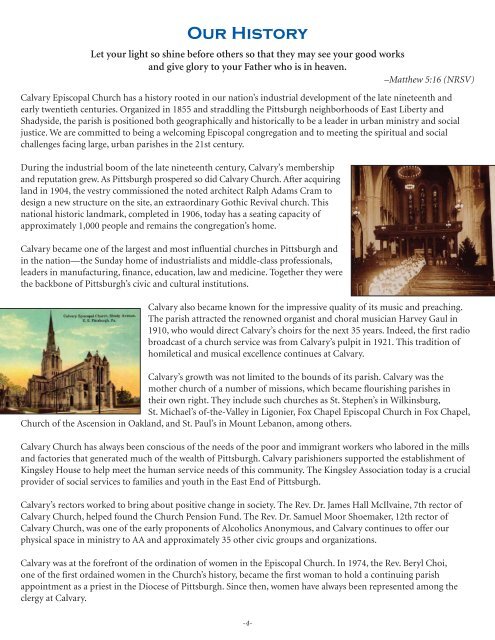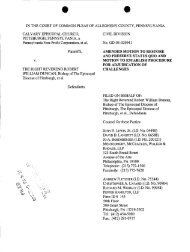Parish Profile - Calvary Episcopal Church
Parish Profile - Calvary Episcopal Church
Parish Profile - Calvary Episcopal Church
You also want an ePaper? Increase the reach of your titles
YUMPU automatically turns print PDFs into web optimized ePapers that Google loves.
Our HistoryLet your light so shine before others so that they may see your good worksand give glory to your Father who is in heaven.–Matthew 5:16 (NRSV)<strong>Calvary</strong> <strong>Episcopal</strong> <strong>Church</strong> has a history rooted in our nation’s industrial development of the late nineteenth andearly twentieth centuries. Organized in 1855 and straddling the Pittsburgh neighborhoods of East Liberty andShadyside, the parish is positioned both geographically and historically to be a leader in urban ministry and socialjustice. We are committed to being a welcoming <strong>Episcopal</strong> congregation and to meeting the spiritual and socialchallenges facing large, urban parishes in the 21st century.During the industrial boom of the late nineteenth century, <strong>Calvary</strong>’s membershipand reputation grew. As Pittsburgh prospered so did <strong>Calvary</strong> <strong>Church</strong>. After acquiringland in 1904, the vestry commissioned the noted architect Ralph Adams Cram todesign a new structure on the site, an extraordinary Gothic Revival church. Thisnational historic landmark, completed in 1906, today has a seating capacity ofapproximately 1,000 people and remains the congregation’s home.<strong>Calvary</strong> became one of the largest and most influential churches in Pittsburgh andin the nation—the Sunday home of industrialists and middle-class professionals,leaders in manufacturing, finance, education, law and medicine. Together they werethe backbone of Pittsburgh’s civic and cultural institutions.<strong>Calvary</strong> also became known for the impressive quality of its music and preaching.The parish attracted the renowned organist and choral musician Harvey Gaul in1910, who would direct <strong>Calvary</strong>’s choirs for the next 35 years. Indeed, the first radiobroadcast of a church service was from <strong>Calvary</strong>’s pulpit in 1921. This tradition ofhomiletical and musical excellence continues at <strong>Calvary</strong>.<strong>Calvary</strong>’s growth was not limited to the bounds of its parish. <strong>Calvary</strong> was themother church of a number of missions, which became flourishing parishes intheir own right. They include such churches as St. Stephen’s in Wilkinsburg,St. Michael’s of-the-Valley in Ligonier, Fox Chapel <strong>Episcopal</strong> <strong>Church</strong> in Fox Chapel,<strong>Church</strong> of the Ascension in Oakland, and St. Paul’s in Mount Lebanon, among others.<strong>Calvary</strong> <strong>Church</strong> has always been conscious of the needs of the poor and immigrant workers who labored in the millsand factories that generated much of the wealth of Pittsburgh. <strong>Calvary</strong> parishioners supported the establishment ofKingsley House to help meet the human service needs of this community. The Kingsley Association today is a crucialprovider of social services to families and youth in the East End of Pittsburgh.<strong>Calvary</strong>’s rectors worked to bring about positive change in society. The Rev. Dr. James Hall McIlvaine, 7th rector of<strong>Calvary</strong> <strong>Church</strong>, helped found the <strong>Church</strong> Pension Fund. The Rev. Dr. Samuel Moor Shoemaker, 12th rector of<strong>Calvary</strong> <strong>Church</strong>, was one of the early proponents of Alcoholics Anonymous, and <strong>Calvary</strong> continues to offer ourphysical space in ministry to AA and approximately 35 other civic groups and organizations.<strong>Calvary</strong> was at the forefront of the ordination of women in the <strong>Episcopal</strong> <strong>Church</strong>. In 1974, the Rev. Beryl Choi,one of the first ordained women in the <strong>Church</strong>’s history, became the first woman to hold a continuing parishappointment as a priest in the Diocese of Pittsburgh. Since then, women have always been represented among theclergy at <strong>Calvary</strong>.-4-




